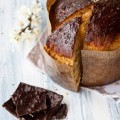Schiacciata alla fiorentina, a sweet flatbread for Carnival and the Italian Table Talk
Being a country girl, in my eyes Florence is a city, it is great and wonderful. The view from Piazzale Michelangelo takes my breath away in any season and at any time of the day. Every time I walk around the city centre I can not help but take a picture – real or mental it’s the same – of the Duomo, from every perspective. I love that moment when I look up to the top, and then higher again, because otherwise you can’t embrace everything with your admired eyes. I look forward to this moment, I hold my breath for a second, and then I let it go with a sigh, the same every time as if it were the first one.

Yet, despite this sense of grandeur that comes over me every time, what I really love about Florence are the tiny back alleys that you may discover only with friends who live there, the private and mysterious look of a garden you see beyond a wall (I may be a bit too influenced by Notting Hill, oopsy Daisy), the small stores and workshops that seem to belong to another time.

In one of these workshops I went to learn how to make schiacciata alla fiorentina, a typical sweet flatbread made during Carnival time. You perfectly know that Carnival is not my favourite time of the year, I see it as the last obstacle between me and the warm weather of spring, though every year I find a reason to save it, its sweets! Last year I tried to fall in love again with Carnival with a feast of typical sweet treats from Siena and Valdelsa, cenci and frittelle.
This year, thanks to the theme we have chosen for this month’s Italian Table Talk, Carnival of course, I decided to give another chance to this holiday and take advantage of a new crush I have for Florence to discover one of its most typical desserts, schiacciata alla fiorentina, also known as stiacciata unta, greased flat bread. Emiko will present a typical sweet of the Florentine carnival, berlingozzo. Valeria, a pure Venetian girl and therefore the best source to learn about the carnival traditions, has made favette (castagnole) and will tell us about her personal experience and the excitement of Carnival seen through her eyes as a child. Jasmine will instead present the Jewish Purim and an evocative sweet treat, chiacchiere alla giudia.
But back to our schiacciata. I took my bus on a winter day so shiny and sunny that seemed almost spring and I went to Florence to visit Andrea Bianchini, a famous chocolatier and pastry chef, to learn how to make a good schiacciata. As I have said many times, it is impossible to talk about a generic Tuscan cuisine, since my region is extremely fragmented when it comes to typical food. Just like with lampredotto, schiacciata alla fiorentina does not cross the boundaries of the city to get to me in Valdelsa, and not only I had not made it before last week, I had never even tasted it. The things you do just for the science sake…

Despite its name that reminds of the savoury flatbread so typical of all our bakeries, schiacciata alla fiorentina is a sweet cake, fragrant with orange and vanilla. During Carnival time it appears in every bakery, pastry shop and bar in Florence. There is even a real competition aiming to nominate the best Florentine schiacciata, though the best one is almost universally attributed to Giorgio. Dusted with icing sugar with the Florence lily on the surface, now it is increasingly served filled with whipped cream, chocolate or custard.
At the beginning the schiacciata was just bread dough enriched with lard. Just remember, Carnival always falls in the period when the pig is traditionally slaughtered, so lard was there, ready to be used. Then it was made even more special by adding sugar, vanilla and oranges, so recognizable in the cake where you use both the grated peel and the juice. Carnival was in fact the last chance to indulge in the pleasures of food and life before Lent – semel in anno licet insanire used to say the Latins, it was a time in which everyone was allowed to break religious and social conventions.

Andrea Bianchini also told me that often the oranges in the traditional Florentine pastries used to be actually bergamots, very common in the area in the past times: as evidence, those round citrus fruit you can see in Della Robbia’s enamelled majolicas are actually bergamots. Another important element of the schiacciata alla fiorentina is its shape, traditionally rectangular. Apparently we owe the success of this cake to the nuns of Santa Verdiana in Florence, who used to serve food to the detainees in rectangular baking trays.
In the past, without going too far back in time, grandmothers would make the schiacciata with leftover bread dough and bake it in the wood oven. I guess oranges, that give to this cake its typical and well recognizable taste, were considered just what is now Bourbon vanilla for us, precious and rare. At a time when a tangerine or an orange were a Christmas gift seen as treasures to be savoured by excited children, just imagine how special and decadent the oranges would make this cake.

– – 2018 updated recipe for schiacciata alla fiorentina – –
This schiacciata is a good compromise between the traditional one made with fresh brewer’s yeast, lard and a double rising and the modern home version, often made with olive oil or butter and baking powder.
Schiacciata alla fiorentina
Print Recipe Pin Recipe Share by EmailIngredients
For the schiacciata fiorentina
- 400 g of plain flour
- 50 g of warm water
- 12 g of fresh brewer's yeast
- 1 egg
- 3 egg yolks
- 100 g of sugar
- 45 g of extra virgin olive oil
- 45 g of butter
- 2 oranges , zest and juice
- 1/2 vanilla pod, seeds
- 1 pinch of salt
- Icing sugar
For the chantilly
- 500 ml of whole milk
- ½ vanilla pod
- 2 eggs
- 4 tablespoons of sugar
- 2 tablespoons corn starch
- 250 ml of whipping cream
Instructions
- Dissolve the fresh brewer’s yeast in 50 g of warm water, then knead it with 100 g of flour. Shape it into a ball and leave it to rise in a covered bowl in a warm place, for about two hours.
- Emulsify the olive oil with the soft butter, the orange zest and the vanilla seeds, then scrape it into a bowl. Add the egg, the egg yolks, the sugar, the orange juice and a pinch of salt and whisk until smooth.
- When the first dough has doubled, add the olive oil, butter and egg mixture and start kneading, adding little by little the rest of the flour. You will get a smooth, soft and very elastic dough.
- Scrape it into a 30 cm x 22 cm rectangular pan and smooth the surface. It must have a 2 cm thickness.
- Leave it to raise, loosely covered, in a warm place for about 3 hours.
- When doubled, bake in a hot oven at 180°C for about 30 minutes. It will be ready when it will be hazel brown, soft and when a toothpick inserted in the centre will come out clean. Let it cool on a wire rack.
- While the schiacciata is cooling down, make the chantilly. Heat the milk with the vanilla pod. Bring it to a soft boiling, then turn off the heat and set it aside.
- In a saucepan whisk the eggs with sugar and corn starch, removing all the lumps. Pour the milk into the eggs in a thin stream, stirring constantly not to cook the eggs.
- Return the saucepan over the stove and cook the custard over low heat, stirring with a whisk, until thick. Remove from the heat as soon as it starts bubbling. Transfer the custard into a bowl, cover it with cling film and let it cool down completely. To speed up the cooling process, immerse the custard bowl into a larger bowl with iced water.
- Whip the cream to soft peaks and gently fold it into the cold custard.
- Slice the schiacciata in half, fill it with the chantilly and sandwich it again, then dust with icing sugar. You can decorate the schiacciata Fiorentina with cocoa powder to reproduce the Florentine lily. Let it rest in the fridge for 30 minutes before serving.

Link love
Not to lose a single post by the Italian Table talk girls, these are our Social Accounts:
- Emiko, her blog is Emikodavies.com, @emikodavies on Twitter, and her Pinterest
- Valeria, her blog is Life Love Food, @valerianecchio on Twitter, her FB Page and her Pinterest
- Jasmine, her blog is Labna.it, @labna on Twitter, her FB page and her Pinterest
- Juls, my twitter @Julskitchen, FB page and Pinterest
The hashtag to follow the conversation on Italian Table talk on Twitter is #ITabletalk (easy, isn’t it?). Tell us which are the typical sweets treat of your Carnival and how you live this crazy moment of the year!










I love the inestigative side of this – “the things you do”! I’m rather partial to schiacciata alla fioretina with just whipped cream, simple and delicious and just the thing on a freezing cold afternoon!
Oh, what a lovely schacciata! It looks and sounds amazing. I can’t wait to try it.
Cheers,
Rosa
I’ve never had a sweet schiacciata before – this looks wonderful and I loved reading about where it comes from.
Mi arrendo: è la terza che vedo stamattina. La dovrò fare pur’io, codesta schiacciata! Detto con una “c” che più aspirata non si pò…
Un saluto, sempre con tanta stima,
Sabrine
Recently made this again- a big hit with friends and coworkers. Was wondering how it would be using 00 flour instead of AP or tipo 0 ( I’m currently in Italy) will it hold up? Thanks
I’d try to find a farina forte, so it could be 00, but check the proteins: more than 12 grams per 100 grams, so it will hold it up!
Oh I wish I could taste this! I just realised when I was in Florence you weren’t with us because you were working, we must do it again together and gaze over that view of Ponte Veccio 🙂
It’s so funny that this should appear on foodgawker today – I am, right this very day, attempting a wild yeast version of this cake! And making it with Chia’s cousin, no less 🙂
What wonderful background on this classic – I have a weekend guest and will certainly prepare schiacciata for Sunday breakfast.
this is perfect for breakfast, it has something of a brioche!
I’m waiting on the rise, but I’m concerned because the biga didn’t completely mix in when adding the liquid and bulk of the flour. I’m an amateur baker so, I imagine it not going to turn out. I may try this with a a more liquid biga next time. the raw dough tastes good though.
Hello Anthony, how did it turn out? was the biga too dry when you tried to incorporate it? maybe next time you can cover it with clingfilm, so it doesn’t dry on the outside.
If you make a more liquid biga, subtract the extra water you’re adding from the liquid ingredients in the second kneading.
Just changed my rating to 5 stars – It was amazing!
I actually made two separate batches – the second biga didn’t dry out so much and easily incorporated – so that one got a better rise. The one with the dried bits of biga didn’t hold the rise as well and I had to pick out the bits of hard dough when I sliced it for the filling (nothing to making a custard without curdling the eggs – just don’t be in a hurry GBB contestants) but it tasted great none the less. The recipe looks daunting for us novices, but not so bad and again, the flavor was amazing…..all gone! Thanks!
ah I am so happy to hear!! great! 🙂
This sounds incredible, and I would love to make it as the dessert for a Tuscan wine pairing meal I’m attending next week. What wine would you suggest I serve with it that I could find in an American wine store. Thank you!
Hello Andrea, I think a vinsanto, our dessert wine, would be perfect!
Perfect — thank you!! ?
And now I’m trying to figure out how to make it gluten free. I may make a completely different cake and use the Chantilly cream as you indicated. It won’t be original, but gluten free never is, and I finally have accepted that! Thank you for your amazing explanations!
Good luck! let me know how it will turn out!
[…] baking, never after. After that, we finished making our pasta and were on to learning how to make a schiacciata fiorentina a traditional Florentine cake that was first made in the 1500’s. We grated and juiced oranges, […]
Hello, I’d like to make this beautiful cake for Easter Sunday! However, I am concerned about the pan size. Would a standard 1/4 sheet cake (jelly roll) pan work (9 1/2″ x 13″) ? In converting measurements, it appears the size of that would be about 24 cm x 33 cm — vs. the 22 cm x 30 cm specified in the recipe. Seems like the 1/4 sheet could be too large, resulting in a cake that’s too thin. I’m not seeing a pan available that I can purchase with the 30 x 22 dimensions. Has anyone tried this recipe with a 1/4 sheet pan? Thanks so much.
Hi Cathy, this would be lovely for Easter! You might want to try with your 1/4 sheet cake and make it slightly smaller with some folded parchment paper.
Let me know how it turns out
Thank you, Giulia! Great idea, I’ll try that and will let you know. Thanks again!
Hello again Giulia! I made your cake for Easter – well worth the effort – it was so special and everyone loved it. Just delicious!
Just a question…what is the reason for preparing a dough ball first, then incorporating the liquid and more flour into that, after it rises? In my case, while I weighed all the ingredients, the first dough was rather firm, so it was a bit difficult to evenly incorporate all the ingredients, along with additional flour to form the second dough. Small pieces of the first dough ball remained intact in the final cake which made it just a bit lumpy.
That said, it was still one of the best and most memorable cakes I’ve ever made. Was just curious about those steps.
Thank you – and thank you for sharing this beautiful recipe!
Cathy
Hello Cathy, sorry for my late answer. I’m so so pleased you enjoyed the schiacciata alla fiorentina, it is such a special cake!
The reason my we make the first dough is because it improves the raising, developing more flavors. It is not sourdough, but close! Probably it was a bit too dry: did you cover it in cling film to prevent it from drying?
Hello Guilia, Thank you for this gorgeous website! Would it work to do the first rise overnight, maybe in the refrigerator? And then in the morning combine that dough with the rest of the ingredients, knead, and do the second rise? Thanks!
Yes! it should work! or you can reduce the fresh yeast and leave it at room temperature overnight. Maybe use just 2 grams?